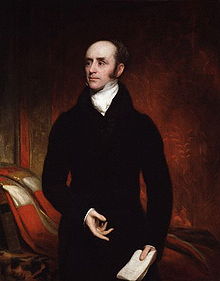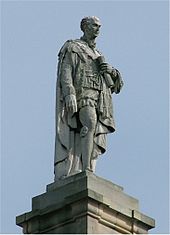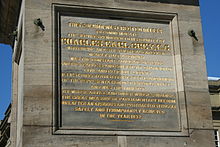- Charles Grey, 2nd Earl Grey
-
The Right Honourable
The Earl Grey
KG PC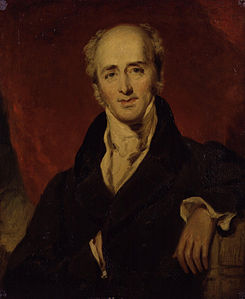
Prime Minister of the United Kingdom In office
22 November 1830 – 16 July 1834Monarch William IV Preceded by The Duke of Wellington Succeeded by The Viscount Melbourne Secretary of State for Foreign Affairs In office
24 September 1806 – 25 March 1807Monarch George III Prime Minister Lord Grenville Preceded by Charles James Fox Succeeded by George Canning Personal details Born 13 March 1764
Fallodon, Alnwick, EnglandDied 17 July 1845 (aged 81)
Howick House, Howick, NorthumberlandPolitical party Whig Alma mater Trinity College, Cambridge Signature 
Charles Grey, 2nd Earl Grey, KG, PC (13 March 1764 – 17 July 1845), known as Viscount Howick between 1806 and 1807, was Prime Minister of the United Kingdom of Great Britain and Ireland from 22 November 1830 to 16 July 1834. A member of the Whig Party, he backed significant reform of the British government and was among the primary architects of the Reform Act 1832. In addition to his political achievements, he famously gave his name to Earl Grey tea.[1]
Contents
Early life
Descended from a long-established Northumbrian family seated at Howick Hall, Grey was the second but eldest surviving son of General Sir Charles Grey KB (1729–1807) and his wife, Elizabeth (1743/4–1822), daughter of George Grey of Southwick, co. Durham. He had four brothers and two sisters. He was educated at Richmond School, followed by Eton and Trinity College, Cambridge,[2] acquiring a facility in Latin and in English composition and declamation that enabled him to become one of the foremost parliamentary orators of his generation. Grey was elected to Parliament at the age of 22 in 1786. He became a part of the Whig circle of Charles James Fox, Richard Brinsley Sheridan, and the Prince of Wales, and soon became one of the major leaders of the Whig party. He was the youngest manager on the committee for prosecuting Warren Hastings. The Whig historian T. B. Macaulay wrote in 1841:
At an age when most of those who distinguish themselves in life are still contending for prizes and fellowships at college, he had won for himself a conspicuous place in Parliament. No advantage of fortune or connection was wanting that could set off to the height his splendid talents and his unblemished honour. At twenty-three he had been thought worthy to be ranked with the veteran statesmen who appeared as the delegates of the British Commons, at the bar of the British nobility. All who stood at that bar, save him alone, are gone, culprit, advocates, accusers. To the generation which is now in the vigour of life, he is the sole representative of a great age which has passed away. But those who, within the last ten years, have listened with delight, till the morning sun shone on the tapestries of the House of Lords, to the lofty and animated eloquence of Charles Earl Grey, are able to form some estimate of the powers of a race of men among whom he was not the foremost.[3]
Grey was also noted for advocating Parliamentary reform and Catholic emancipation. His affair with the Duchess of Devonshire, herself an active political campaigner, did him little harm although it nearly caused her to be divorced by her husband.
In 1806, Grey, by then Lord Howick owing to his father's elevation to the peerage as Earl Grey, became a part of the Ministry of All the Talents (a coalition of Foxite Whigs, Grenvillites, and Addingtonites) as First Lord of the Admiralty. Following Fox's death later that year, Howick took over both as Foreign Secretary and as leader of the Whigs.
The government fell from power the next year, and, after a brief period as a Member of Parliament for Appleby from May to July 1807, Howick went to the Lords, succeeding his father as Earl Grey. He continued in opposition for the next 23 years.
Great Reform Act
In 1830, the Whigs finally returned to power, with Grey as Prime Minister. His Ministry was a notable one, seeing passage of the Reform Act 1832, which finally saw the reform of the House of Commons, and the abolition of slavery throughout the British Empire in 1833. As the years had passed, however, Grey had become more conservative, and he was cautious about initiating more far-reaching reforms. In 1834 Grey retired from public life, leaving Lord Melbourne as his successor.
Grey returned to Howick but kept a close eye on the policies of the new cabinet under Melbourne, whom he, and especially his family, regarded as a mere understudy until he began to act in ways of which they disapproved. Grey became more critical as the decade went on, being particularly inclined to see the hand of Daniel O'Connell behind the scenes and blaming Melbourne for subservience to the radicals with whom he identified the Irish patriot. He made no allowances for Melbourne's need to keep the radicals on his side to preserve his shrinking majority in the Commons, and in particular he resented any slight on his own great achievement, the Reform Act, which he saw as a final solution of the question for the foreseeable future. He continually stressed its conservative nature. As he declared in his last great public speech, at the Grey Festival organized in his honour at Edinburgh in September 1834, its purpose was to strengthen and preserve the established constitution, to make it more acceptable to the people at large, and especially the middle classes, who had been the principal beneficiaries of the Reform Act, and to establish the principle that future changes would be gradual, "according to the increased intelligence of the people, and the necessities of the times".[4] It was the speech of a conservative statesman.[5]
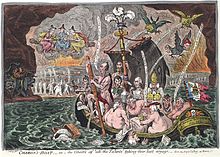 In Charon's Boat (1807), James Gillray caricatured the fall from power of the Whig administration, with Howick taking the role of Charon rowing the boat.
In Charon's Boat (1807), James Gillray caricatured the fall from power of the Whig administration, with Howick taking the role of Charon rowing the boat.
Retirement
Grey spent his last years in contented, if sometimes fretful, retirement at Howick, with his books, his family, and his dogs. He became physically feeble in his last years and died quietly in his bed on 17 July 1845, forty-four years to the day since going to live at Howick.[6] He was buried in the church there on the 26th in the presence of his family, close friends, and the labourers on his estate.[5]
Commemoration
Earl Grey tea, a blend which uses bergamot oil to flavour the beverage, is named after Grey. He is commemorated by Grey's Monument in the centre of Newcastle upon Tyne, which consists of a statue of Lord Grey standing atop a 41 m (135 ft) high column. The monument was once struck by lightning and Earl Grey's head was seen lying in the gutter in Grey Street. The monument lends its name to Monument Metro station on the Tyne and Wear Metro located directly underneath. Grey Street in Newcastle upon Tyne and Grey College, Durham are also named after Grey.
Personal life
Grey married Mary Elizabeth Ponsonby (1776–1861), only daughter of William Ponsonby, 1st Baron Ponsonby and Hon. Louisa Molesworth in 1794. The marriage was a fruitful one; between 1796 and 1819 the couple had ten sons and six daughters:
- [a dau.] Grey (stillborn, 1796)
- Lady Louisa Elizabeth Grey ( 7 Apr 1797-26 November 1841); married John Lambton, 1st Earl of Durham
- Lady Elizabeth Grey (10 July 1798- 8 November 1880); married John Crocker Bulteel (d. 10 September 1843). Their daughter, Louisa Emily Charlotte Bulteel, is one of the great-great-great-grandmothers of Diana, Princess of Wales
- Lady Caroline Grey (30 August 1799-28 April 1875); married Capt. The Hon. George Barrington
- Lady Georgiana Grey (17 Feb 1801-1900); never married
- Henry George Grey, 3rd Earl Grey (28 December 1802- 9 October 1894), eldest son, who became a politician like his father
- General Sir Charles Grey (15 March 1804-31 March 1870), father of Albert Grey, 4th Earl Grey
- Admiral Sir Frederick William Grey (23 August 1805- 2 May 1878)
- Lady Mary Grey ( 2 May 1807- 6 July 1884); married Charles Wood, 1st Viscount Halifax
- Hon. William Grey (13 May 1808-11 Feb 1815)
- Admiral The Hon. George Grey (16 May 1809- 3 October 1891)
- Hon. Thomas Grey (29 Dec 1810- 8 Jul 1826)
- Rev. Hon. John Grey ( 2 March 1812-11 November 1895)
- Rev. Hon. Sir Francis Richard Grey (31 March 1813-22 March 1890) married Lady Elizabeth Howard (1816–1891), daughter of George Howard, 6th Earl of Carlisle and Georgiana Cavendish (daughter of Georgiana Cavendish, Duchess of Devonshire).
- Hon. Henry Cavendish Grey (16 October 1814- 5 September 1880)
- Hon. William George Grey (15 February 1819-19 December 1865)
Mary was frequently pregnant and during his absences in London or elsewhere Grey had a series of affairs with other women. The first, most notorious, and most significant, which antedated his engagement to his future wife, was with Georgiana Cavendish, Duchess of Devonshire, whom he met at Devonshire House – the centre of Whig society in London in the 1780s and 1790s – shortly after his arrival in the capital as a young recruit to the House of Commons. Impetuous and headstrong, Grey pursued Georgiana with persistence until she gave in to his attentions. She became pregnant by Grey in 1791, but she refused to leave her husband the duke, and live with Grey, when the duke threatened that if she did so she would never see their children again. She went abroad with Elizabeth Foster, and on 20 February 1792 at Aix-en-Provence, gave birth to a daughter who was given the name Eliza Courtney. After their return to England in September 1793 the child was taken to Fallodon and brought up by Grey's parents as though she were his sister. This affair was a significant step in the process by which he became a member of the Whig party, led by Charles James Fox.[5]
Lord Grey's Ministry, November 1830 – July 1834
- Lord Grey — First Lord of the Treasury and Leader of the House of Lords
- Lord Brougham — Lord Chancellor
- Lord Lansdowne — Lord President of the Council
- Lord Durham — Lord Privy Seal
- Lord Melbourne — Secretary of State for the Home Department
- Lord Palmerston — Secretary of State for Foreign Affairs
- Lord Goderich — Secretary of State for War and the Colonies
- Sir James Graham — First Lord of the Admiralty
- Lord Althorp — Chancellor of the Exchequer and Leader of the House of Commons
- Charles Grant — President of the Board of Control
- Lord Holland — Chancellor of the Duchy of Lancaster
- The Duke of Richmond — Postmaster-General
- Lord Carlisle — Minister without Portfolio
Changes
- June, 1831 — Lord John Russell, the Paymaster of the Forces, and Edward Smith-Stanley, the Chief Secretary for Ireland, join the Cabinet.
- April, 1833 — Lord Goderich, now Lord Ripon, succeeds Lord Durham as Lord Privy Seal. Edward Smith-Stanley succeeds Ripon as Secretary of State for War and the Colonies. His successor as Chief Secretary for Ireland is not in the Cabinet. Edward Ellice, the Secretary at War, joins the Cabinet.
- June, 1834 — Thomas Spring Rice succeeds Stanley as Colonial Secretary. Lord Carlisle succeeds Ripon as Lord Privy Seal. Lord Auckland succeeds Graham as First Lord of the Admiralty. The Duke of Richmond leaves the Cabinet. His successor as Postmaster-General is not in the Cabinet. Charles Poulett Thomson, the President of the Board of Trade, and James Abercrombie, the Master of the Mint, join the Cabinet.
In popular culture
Charles Grey is portrayed by Dominic Cooper in the 2008 film The Duchess, directed by Saul Dibb and starring Ralph Fiennes and Keira Knightley. The film is based on Amanda Foreman's biography of Georgiana Cavendish, Duchess of Devonshire.
He is also a secondary character in Emma Donoghue's 2004 book Life Mask.
Notes
- ^ Kramer, Ione. All the Tea in China. China Books, 1990. ISBN 0835121941. Pages 180-181.
- ^ Grey, Charles in Venn, J. & J. A., Alumni Cantabrigienses, Cambridge University Press, 10 vols, 1922–1958.
- ^ Thomas Babington Macaulay, ‘Warren Hastings’, Edinburgh Review LXXIV (October, 1941), pp. 160-255.
- ^ Edinburgh Weekly Journal, 17 September 1834.
- ^ a b c E. A. Smith, ‘Grey, Charles, second Earl Grey (1764–1845)’, Oxford Dictionary of National Biography, Oxford University Press, Sept 2004; online edn, May 2009, accessed 13 Feb 2010.
- ^ GRO Register of Deaths: SEP 1845 XXV 130 ALNWICK
References
- The Encyclopædia Britannica; A Dictionary of Arts, Sciences, Literature and General Information. New York: Encyclopædia Britannica, 1910. (pp. 586–588) googlebooks Accessed 10 May 2008
- Mosley, Charles (editor). (1999). Burke's Peerage & Baronetage, 106th edition
- E. A. Smith, "Grey, Charles, second Earl Grey (1764–1845)", Oxford Dictionary of National Biography, Oxford University Press, 2004.
- E. A. Smith, Lord Grey, 1764–1845 (1990)
- G. M. Trevelyan, Lord Grey of the Reform Bill (1920) 413pp; full text online·
- "10 Downing Street website, PMs in history". http://www.number10.gov.uk/history-and-tour/prime-ministers-in-history/earl-grey. Retrieved 2006-07-26.
External links
- Hansard 1803–2005: contributions in Parliament by Charles Grey
- More about Earl Grey on the Downing Street website.
- Works by or about Charles Grey, 2nd Earl Grey in libraries (WorldCat catalog)
Parliament of Great Britain Preceded by
Lord Algernon Percy
Sir William Middleton, BtMember of Parliament for Northumberland
1786 – 1800
With: Sir William Middleton, Bt
Thomas Richard BeaumontSucceeded by
Parliament of the United KingdomParliament of the United Kingdom Preceded by
Parliament of Great BritainMember of Parliament for Northumberland
1801 – 1807
With: Thomas Richard BeaumontSucceeded by
Earl Percy
Thomas Richard BeaumontPreceded by
Sir Philip Francis
John CourtenayMember of Parliament for Appleby
May 1807 – July 1807
With: James Ramsay CuthbertSucceeded by
Nicholas William Ridley-Colborne
James Ramsay CuthbertPreceded by
Richard FitzPatrick
Lord William RussellMember of Parliament for Tavistock
July 1807 – November 1807
With: Lord William RussellSucceeded by
George Ponsonby
Lord William RussellPolitical offices Preceded by
The Lord BarhamFirst Lord of the Admiralty
1806Succeeded by
Thomas GrenvillePreceded by
Charles James FoxForeign Secretary
1806–1807Succeeded by
George CanningLeader of the House of Commons
1806–1807Succeeded by
Spencer PercevalPreceded by
The Duke of WellingtonPrime Minister of the United Kingdom
22 November 1830 – 16 July 1834Succeeded by
The Viscount MelbourneLeader of the House of Lords
1830–1834Party political offices Preceded by
None recognised beforeLeader of the British Whig Party
1830-1834Succeeded by
The Viscount MelbournePreceded by
None recognised beforeWhig Leader in the Lords
1830-1834Succeeded by
The Viscount MelbournePeerage of the United Kingdom Preceded by
Charles GreyEarl Grey
1807–1845Succeeded by
Henry GreyCategories:- Prime Ministers of the United Kingdom
- British Secretaries of State for Foreign Affairs
- Lords of the Admiralty
- Members of the Privy Council of the United Kingdom
- Whig (British political party) MPs
- Old Etonians
- Alumni of Trinity College, Cambridge
- Knights of the Garter
- People from Northumberland
- Earls in the Peerage of the United Kingdom
- 1764 births
- 1845 deaths
- Members of the United Kingdom Parliament for English constituencies
- Members of the Parliament of Great Britain for English constituencies
- Leaders of the House of Commons
- Leaders of the House of Lords
- Grey family
- People from Richmond, North Yorkshire
Wikimedia Foundation. 2010.

